Kate O. Sessions, shaper of San Diego’s green legacy
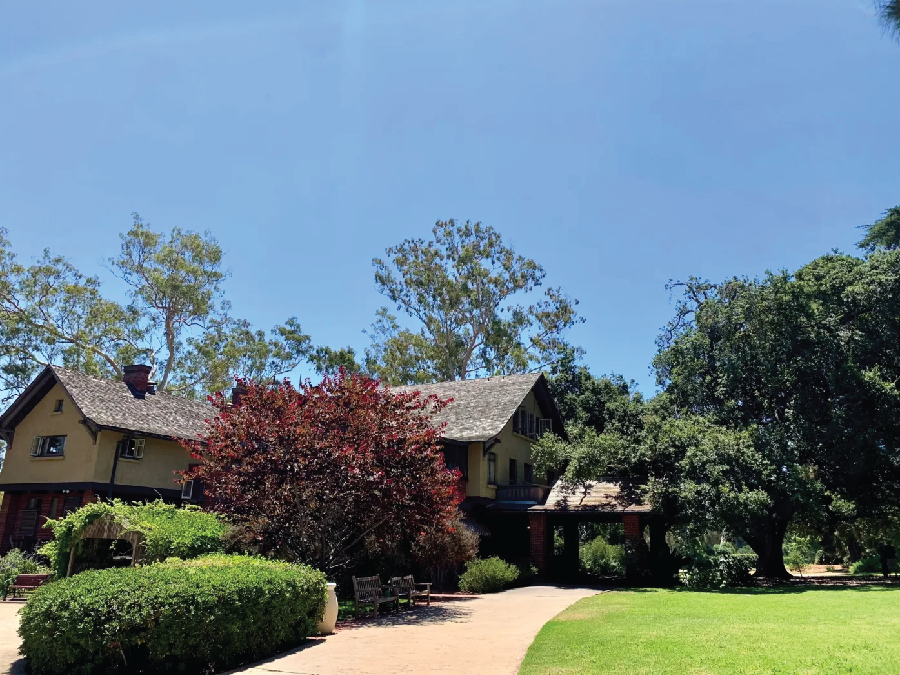
Sessions contributed expertise to complete the Marston Home’s garden, preserving its original design. Century-old Tasmanian blue gums (Eucalyptus globulus) behind the home serve as cautionary reminders of the need for thoughtful planting in our delicate ecosystems. (Helen Purcell Montag)
As advocate for climate-appropriate plants, she helped establish botanical treasures across the city, including Balboa Park
By Helen Purcell Montag
(This article originally appeared in the Nov 9, 2024 issue of the San Diego Union Tribune)
A bronze statue at Balboa Park’s west entrance honors Kate O. Sessions (1857-1940), a pioneering figure in San Diego’s botanical history. Yet her influence on shaping the city’s environment remains largely untold. Sessions arrived in San Diego from the Bay Area with a UC Berkeley science degree for a teaching position. Her career soon shifted to plant cultivation
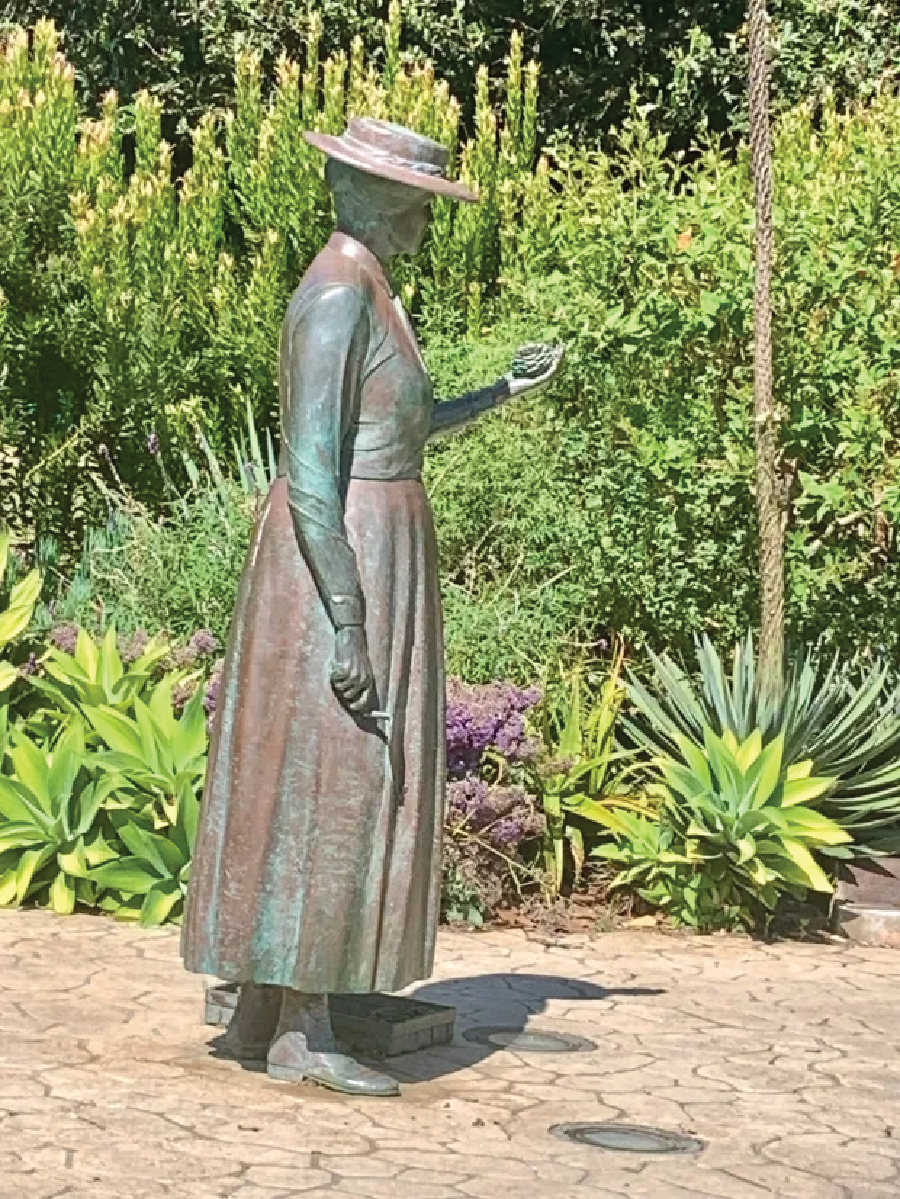
Kate O. Sessions (1857-1940) transformed San Diego’s landscape by introducing climate-appropriate plants to our coastlines, mesas and canyons. Sessions’ visionary work reshaped the city’s environment, leaving a living legacy for future generations. (Helen Purcell Montag)
In City Park (today’s Balboa Park), Sessions cultivated various species of acacias, palms, and pines. The park boasts a living legacy of mature trees from Sessions’ time there: San José Palms (Brahea brandegeei), now gracing Cabrillo Canyon by the hundreds. (Helen Purcell Montag)
Sessions’ passion for horticulture, scientific acumen and civic dedication contributed to a remarkable metamorphosis of our city’s terrain. The origin of the word horticulture — hortus, for garden and colere, to cultivate — captures the essence of her life’s work. Let’s explore San Diego’s landmark places to see how one person’s botanical expertise and urban commitment shaped local landscapes. We’ll visit sites Sessions helped create and shape.
City Park (today’s Balboa Park)
In 1892, Sessions leased 30 acres from San Diego’s City Council to establish a nursery at City Park’s northwest corner. She agreed to plant 100 trees in the park annually and provide 300 trees for public spaces and schoolyards. Sessions introduced various species of acacias, palms and pines. Her trip to the Baja peninsula yielded a botanical treasure: San José palm (Brahea brandegeei) seeds that she cultivated and planted in Cabrillo Canyon.
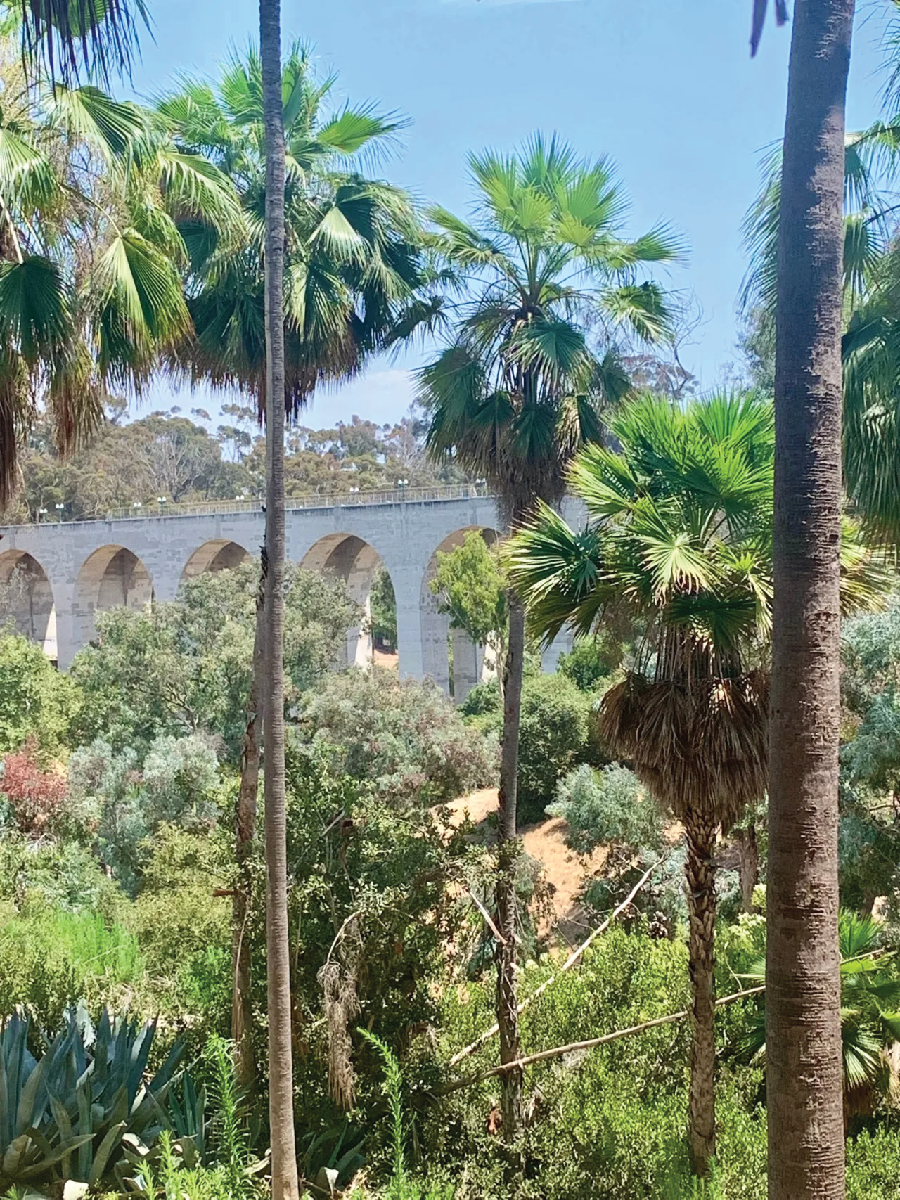
In City Park (today’s Balboa Park), Sessions cultivated various species of acacias, palms, and pines. The park boasts a living legacy of mature trees from Sessions’ time there: San José Palms (Brahea brandegeei), now gracing Cabrillo Canyon by the hundreds. (Helen Purcell Montag)
Sessions found a kindred spirit in George W. Marston, a successful businessman and civic leader who shared her passion for urban beautification and transforming public spaces. In 1903, Marston launched an ambitious campaign for City Park. Over the next 12 years, City Park’s sparse landscape transformed into a vibrant urban space. It was renamed Balboa Park, the site of the 1915 Panama-California Exposition. Though Sessions’ city lease ended, her collaborations with Marston continued throughout her life.
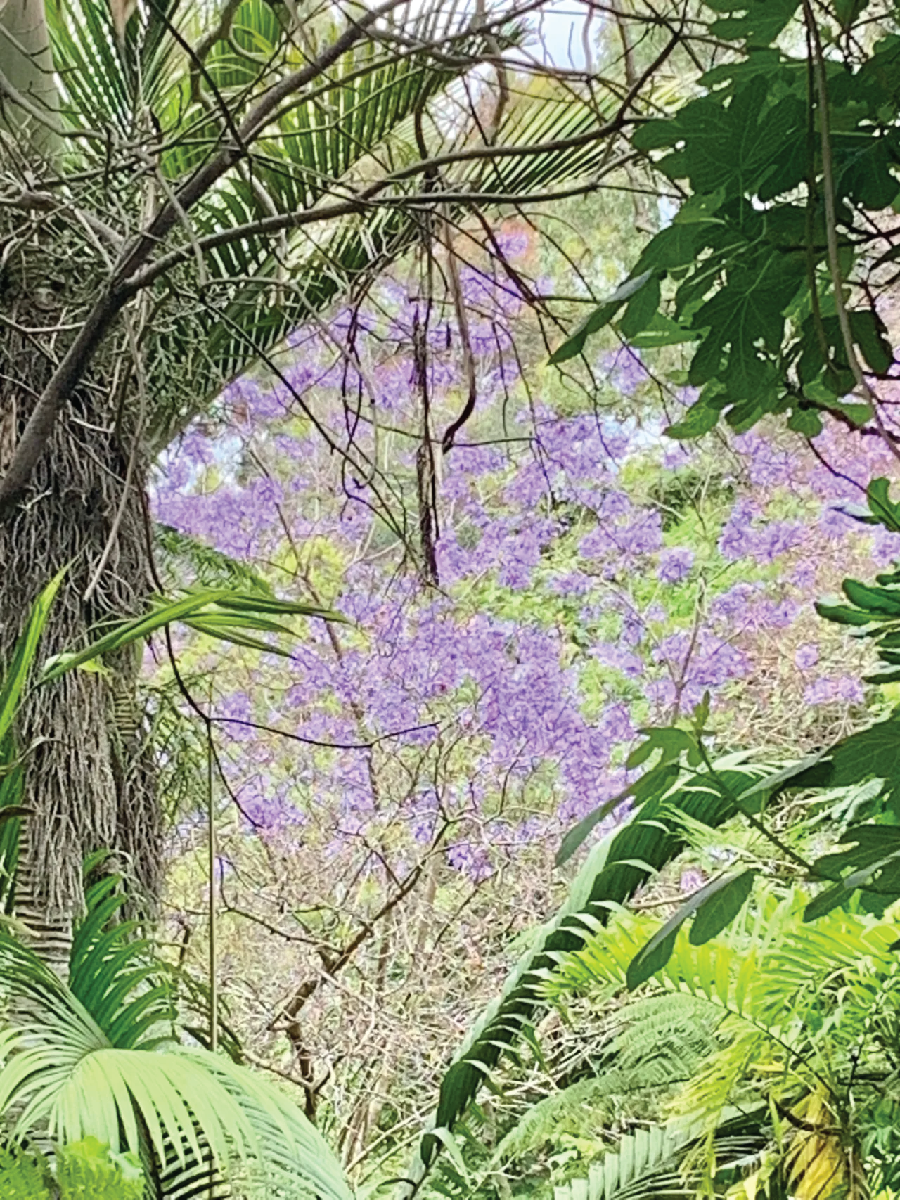
The historic Mission Hills neighborhood has curvilinear streets with mature gardens and trees. Sessions’ legacy blossoms each spring in displays of lavender trumpet-shaped flowers of the Jacaranda (Jacaranda mimosifolia) trees, which she introduced to the city. (Helen Purcell Montag)
Mission Hills
Sessions relocated her business to Mission Hills, a neighborhood with panoramic city and bay views. The nursery she established on Fort Stockton Drive, still in operation today, supplied many plants and trees that contributed to the neighborhood’s appeal. This historic area boasts curvilinear streets with gardens and mature trees. Return in late spring to witness Sessions’ legacy in full bloom when the Jacarandas (Jacaranda mimosifolia) she introduced display their lavender, trumpet-shaped flowers.
San Diego Floral Association and California Garden Magazine
In 1907, Sessions co-founded the San Diego Floral Association and for over four decades contributed to its magazine, California Garden, still published today. Her pen proved to be as mighty as her trowel, educating readers through articles rich with gardening knowledge and travel insights. Modern enthusiasts can explore Sessions’ timeless botanical wisdom through “The Complete Writings of Kate Sessions in California Garden.” This resource preserves Sessions’ horticultural legacy, showcasing her dual impact as gardener and educator.
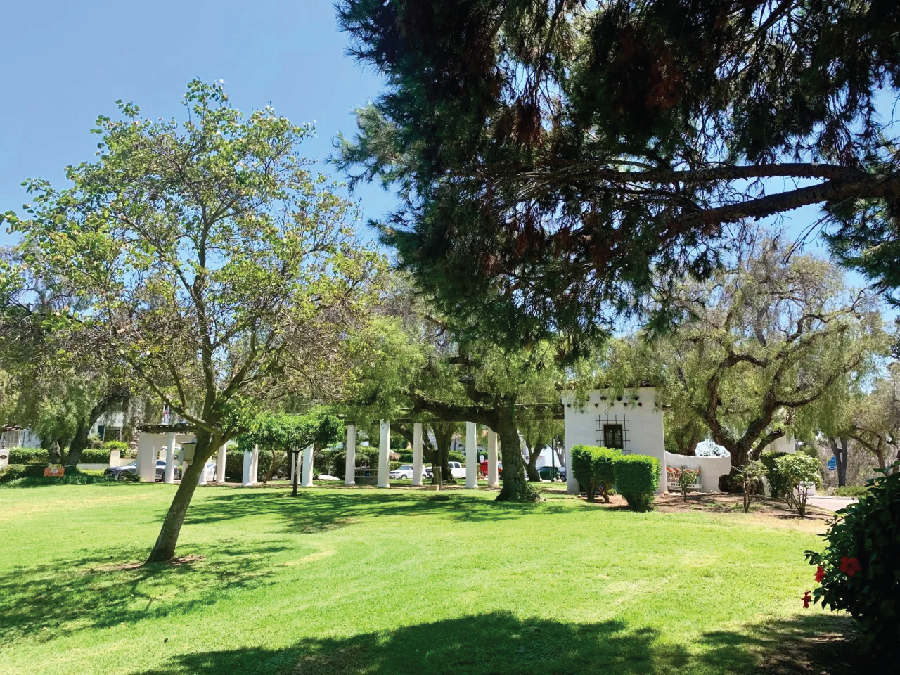
The Presidio Route and Planting guide provides text and maps for the park’s trees and plants, including a majestic Aleppo Pine (Pinus halepensis) near the pergola on Presidio Drive. (Helen Purcell Montag)
Marston Home Garden
Marston’s arts and crafts home harmoniously blends indoor and outdoor spaces. Sessions contributed her expertise to complete the garden, retaining its initial design. A large native live oak (Quercus agrifolia) frames the property, inviting further exploration. Century-old Tasmanian blue gums stand majestically behind the home. Eucalyptuses, once celebrated for swift growth, now offer a lesson in ecological foresight. Today’s gardeners, wary of eucalyptus trees’ invasive nature and fire risk, favor native species to protect local ecosystems.
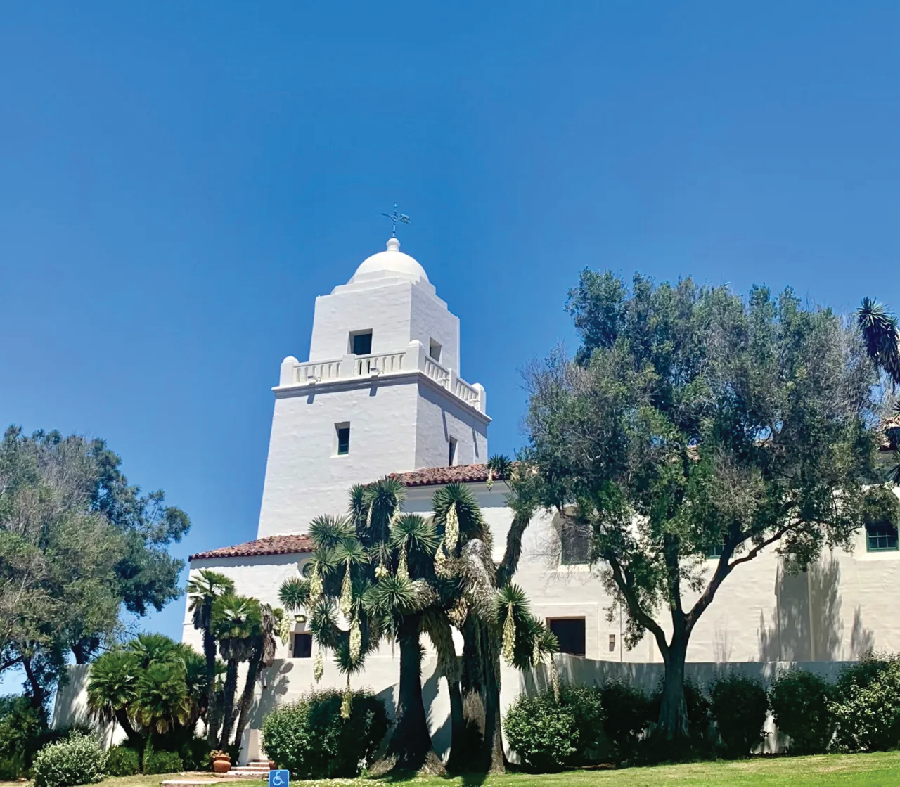
Marston transformed Presidio Hill into a historical park, building the Junípero Serra Museum as its centerpiece and gifting this National Historic Landmark to San Diego in 1929. Sessions contributed her horticultural expertise, recommending drought-resistant trees for the park’s landscaping. (Helen Purcell Montag)
Presidio and Serra Museum
Marston acquired Presidio Hill and transformed it into a park honoring San Diego’s early history. He built the Junípero Serra Museum, the centerpiece of this National Historic Landmark, and gifted it to the city in 1929. Sessions lent her horticultural expertise to Marston, favoring resilient pine trees suitable to San Diego’s arid climate. A detailed Presidio Route and Planting guide keyed to text helps you discover the park’s trees and plants. Look for the Aleppo pine (Pinus halepensis) that rises gracefully beside the pergola on Presidio Drive.
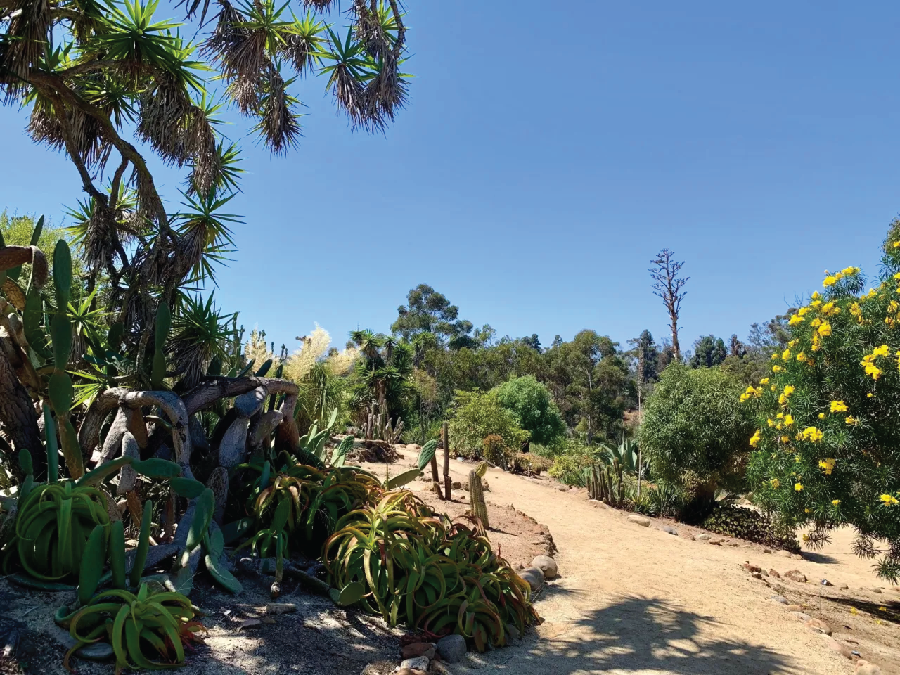
The recently renamed Kate O. Sessions Cactus Garden in Balboa Park epitomizes its namesake’s vision for sustainable horticulture. The original Cactus Garden was championed by Sessions for the 1935 California Pacific International Exposition. (Helen Purcell Montag)
Kate O. Sessions Cactus Garden
The recently renamed Kate O. Sessions Cactus Garden in Balboa Park epitomizes its namesake’s vision for sustainable horticulture. Championed by Sessions for the 1935 California Pacific International Exposition, the original cactus garden displayed arid-climate plants, introducing visitors to waterwise landscaping. Today, this xeriscape wonderland on Balboa Park Club’s west side flourishes with diverse cacti and succulents from around the world. Saguaros, agaves and aeoniums thrive, reflecting Sessions’ commitment to sustainable plantings.
Fairchild and Meyer Medal
Sessions and USDA botanist David Fairchild forged a partnership, drawing on their complementary expertise — Sessions’ deep familiarity with San Diego’s climate and Fairchild’s global plant explorations. With her scientific mind, Sessions meticulously evaluated exotic species, providing crucial insights about their adaptability to San Diego’s environment. This collaboration advanced botanical diversity both locally and nationwide. In 1939, Sessions became the first woman to receive the Frank N. Meyer Medal for foreign plant introduction from the American Genetic Association, a recognition she earned through Fairchild’s nomination.
The next time you visit Kate O. Sessions’ bronze statue in Balboa Park, especially in her November birthday month, reflect on this botanical trailblazer’s enduring legacy. Sessions’ achievements — groundbreaking for a woman of her time — offer lasting lessons in vision and perseverance. Her civic spirit and horticultural expertise shaped our urban landscape. The diverse urban canopy she cultivated is a precious gift to San Diego. May her story inspire your waterwise gardening and connection to our urban greenery!
Purcell Montag is an active UC Master Gardener who also enjoys history, travel, writing, genealogy and speaking Spanish.

